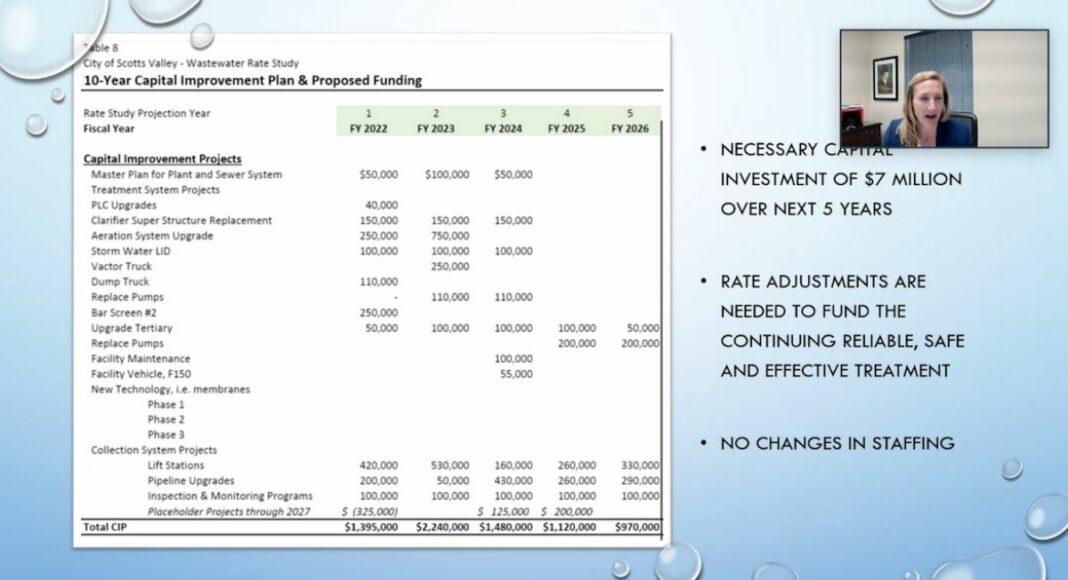The Scotts Valley City Council unanimously passed its annual budget on June 16, dipping into its rainy day fund in hopes of being catapulted back to financial health after the novel coronavirus sent finances into disarray.
The $1.4 million deficit plan will draw down reserves to $4 million, but staff said that, as business recovers, residents will finally start to see the full effects of the 1.25% sales tax (Measure Z) approved by voters last year.
“This year is a recovering budget,” City Manager Tina Friend said in an interview after the June 16 meeting. “This year is kind of this bridge year.”
The city will spend $4.98 million on wastewater, $470,000 on recreation, $580,000 on capital improvements and $14.11 million in general expenses in 2021-22.
Police will get $5.51 million and Public Works will get $2.06 million. In addition, the city will spend $1.84 million on administration and $1.46 million on community development.
“About half of General Fund revenues come from very volatile sources,” Friend said, pointing to the cratering of hotel and sales tax revenues during the pandemic. “We took a big hit.”
Nevertheless, the city is in a relatively healthy position, all things considered, Friend said.
“Our budget is growing a bit,” she said. “We knew that we had healthy reserves.”
Last year, the entire parks department was laid off, as the community struggled to stay afloat when the novel coronavirus showed up—among other staffing reductions.
But now the city will be able to hire, or increase hours, more aggressively, Friend noted, adding that she’s also excited about the ongoing civic planning process this will allow for.
Scotts Valley is smack-dab in the middle of multiple long-term efforts. Its strategic plan—the “development blueprint”—has already cleared the community input phase. But it’s now being evaluated for potential environmental impacts.
Friend’s said she is thrilled the city will finally be able to update its zoning code, for one.
Scotts Valley is also updating its vision for a Town Center commercial core—which a consultant recently suggested will need a mix of new office, retail and residential space to succeed.
In addition, the city is revamping the boundaries for where affordable housing requirements are triggered (to be in line with the community’s perimeter) to give developers more clarity—and to get more inexpensive units built.
The budget also factors in commitments to public pensions, something many Californian municipalities have struggled with in recent years.
The state had assumed a way too aggressive rate of return on investments, and Scotts Valley had been forced to help them play catchup for a few more years, Friend explained.
“We are seeing our retirement costs increase every year,” she said. “We’ve recalibrated.”
In fact, Scotts Valley is taking the more conservative approach of assuming an even less favorable performance than the Sacramento bureaucrats are, so it doesn’t end up in the same situation again.
This year that’s a $679,000 contribution for Scotts Valley employees, plus $1.51 million to cover the prior financial misjudgment.
But while other municipalities have turned to something called a “pension obligation bond”—and Scotts Valley has considered this—it hasn’t gone down that road, yet, Friend said.
The city’s Capital Improvement Program is one of the main focuses of the budget.
Friend says the CIP is about investing in the specific projects that will make Scotts Valley a more attractive place to live and work—not to mention travel to—in the long run.
“For the most part we try to build out a realistic plan,” she said, adding that while the CIP looks five years into the future, “that first year is the most accurate.”
The CIP includes Bean Creek Road improvements—all the way to the city limits.
“It’s in very poor shape,” she said.
Under the plan, there will be investments in recreation infrastructure, including Skypark playground equipment (they already have a $200,000 state parks grant in place—coming from Prop 68 money).
Plus, the Siltanen Family Swim Center is set for a facelift.
“Getting our pool back up-and-running means so much,” Friend said. “Countless kids in Scotts Valley have taken swim lessons there.”
The budget will also allow for the Active Transportation Plan, finalized in April, to move forward—hopefully with a new public works director at the helm.
On Wastewater: 9% hike and future plans
During the meeting, council members unanimously approved a sizable wastewater rate hike: 9% per year, for five years.
The money will help Scotts Valley go shopping for a brand-new plant. Because, while the current one gets the job done (before being piped down to Santa Cruz and then deep into the Pacific Ocean), there are lots of problems with it.
“We rely on microbes,” Friend said, adding staff has to closely monitor the chemistry. “It can get overwhelmed, and we have to shut it down.”
From pumps that are failing to rust chewing through the metal, Friend said it is ailing health.
“We are starting to plan for the next generation of wastewater technology,” she said, adding that could mean stocking up on a super green irrigation system. “There is such a changing paradigm out there about the value of wastewater.”
The first step in moving beyond the current “activated sludge” treatment plant, which was built in 1997, has already been completed. Earlier this month Kennedy/Jenks Consultants, Inc. beat out one other firm to secure up to $79,873 for a Wastewater Options Study.
“We said cast a far and wide net,” Friend said. “We’re on the cusp of something exciting.”













